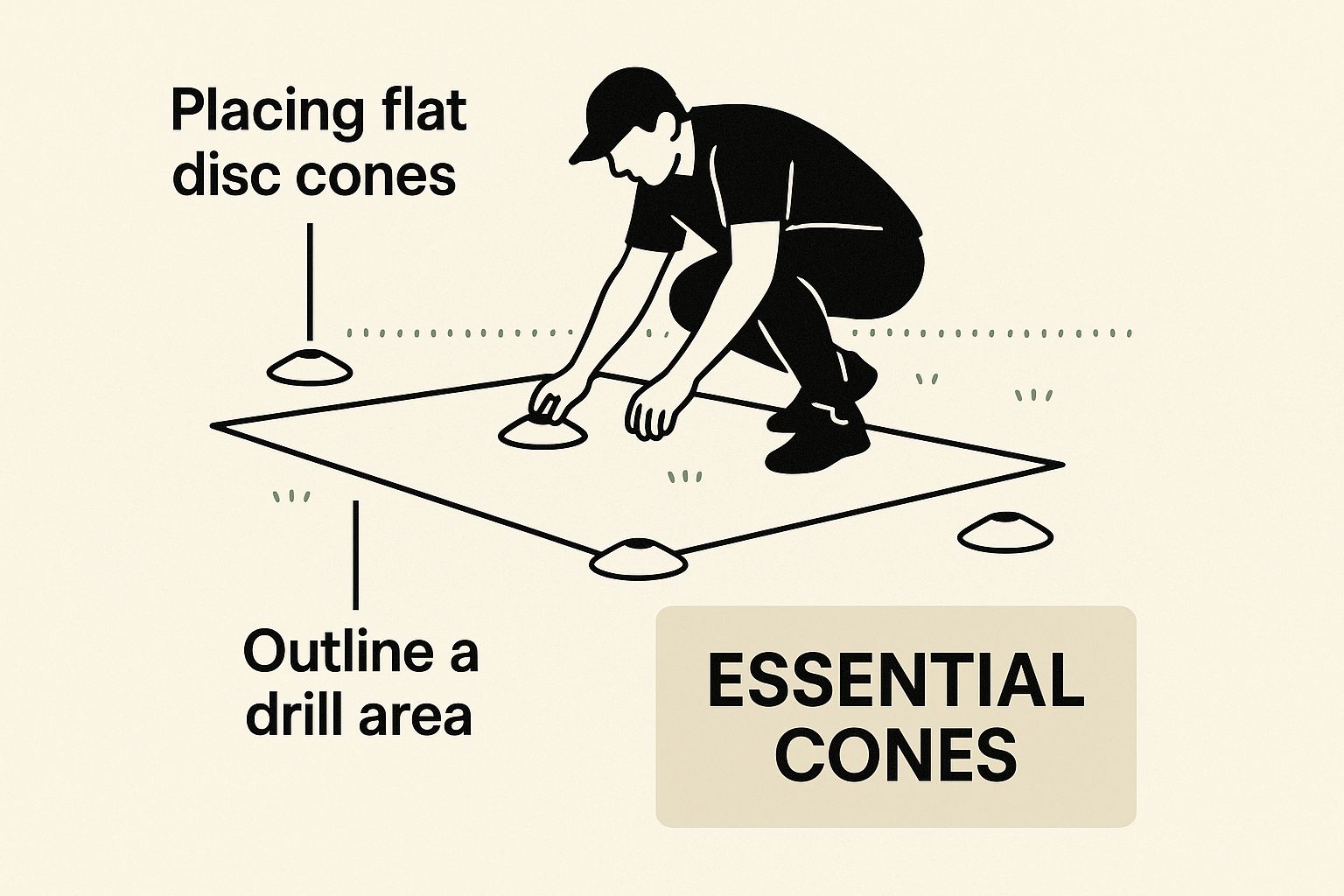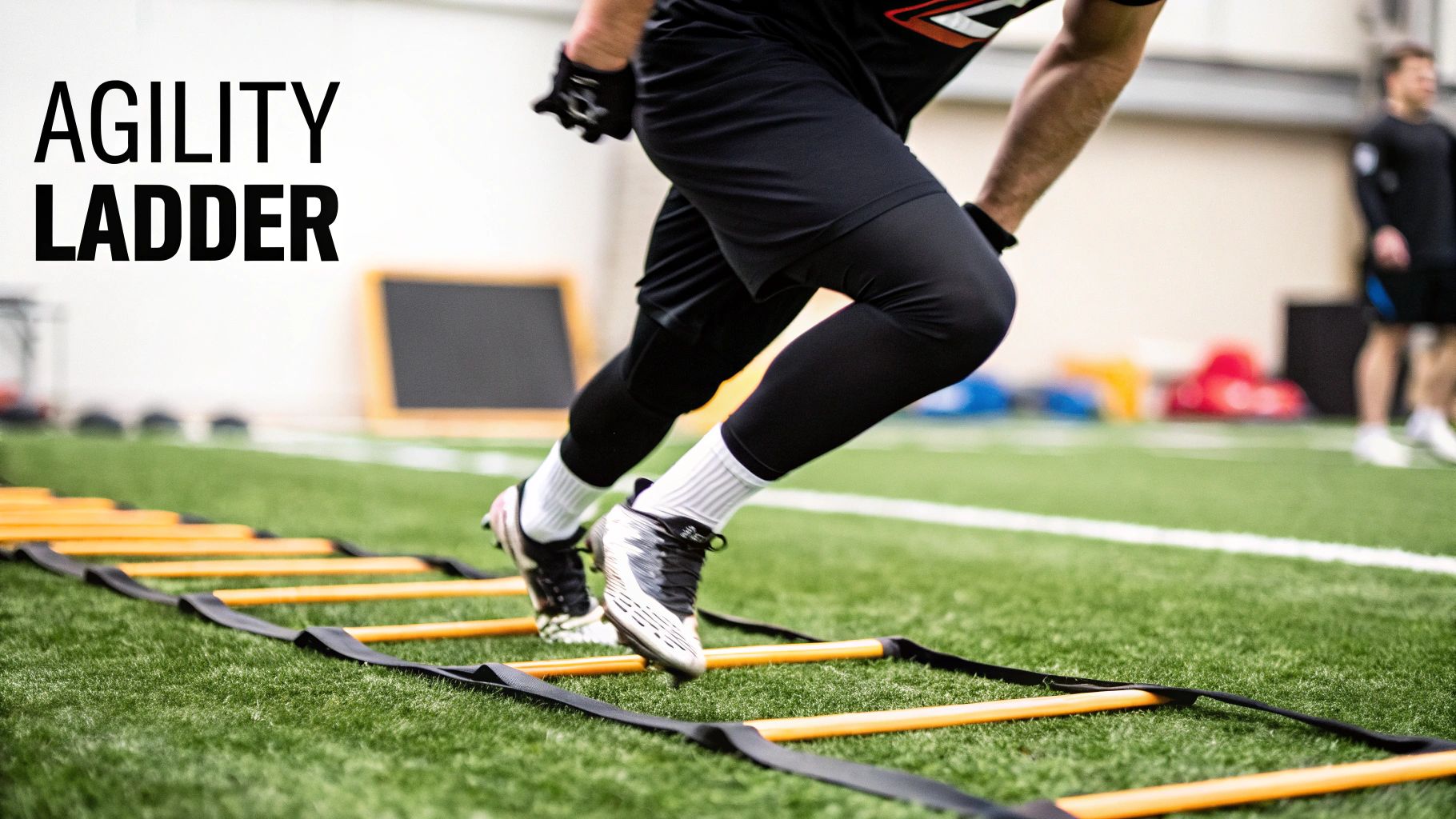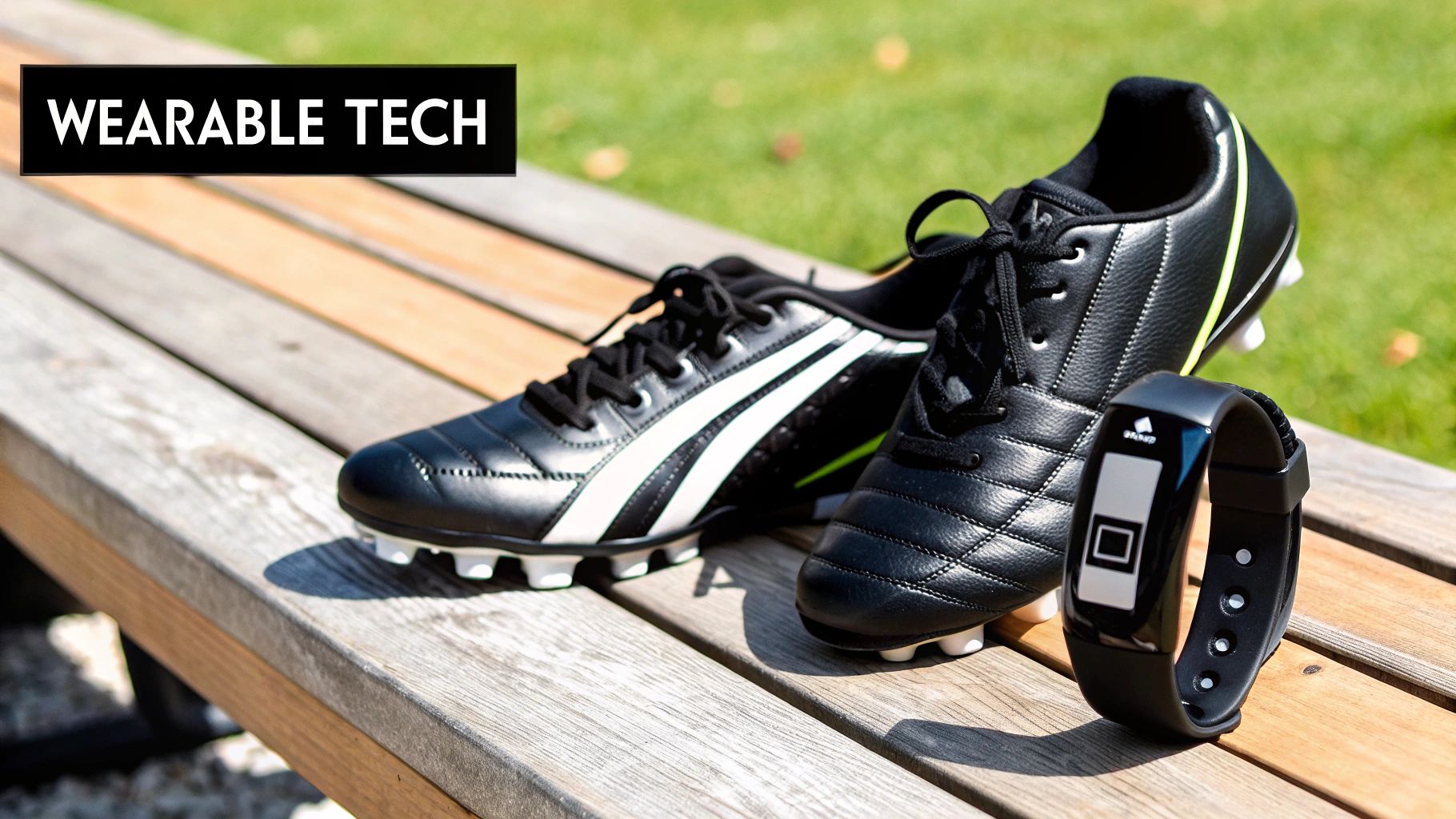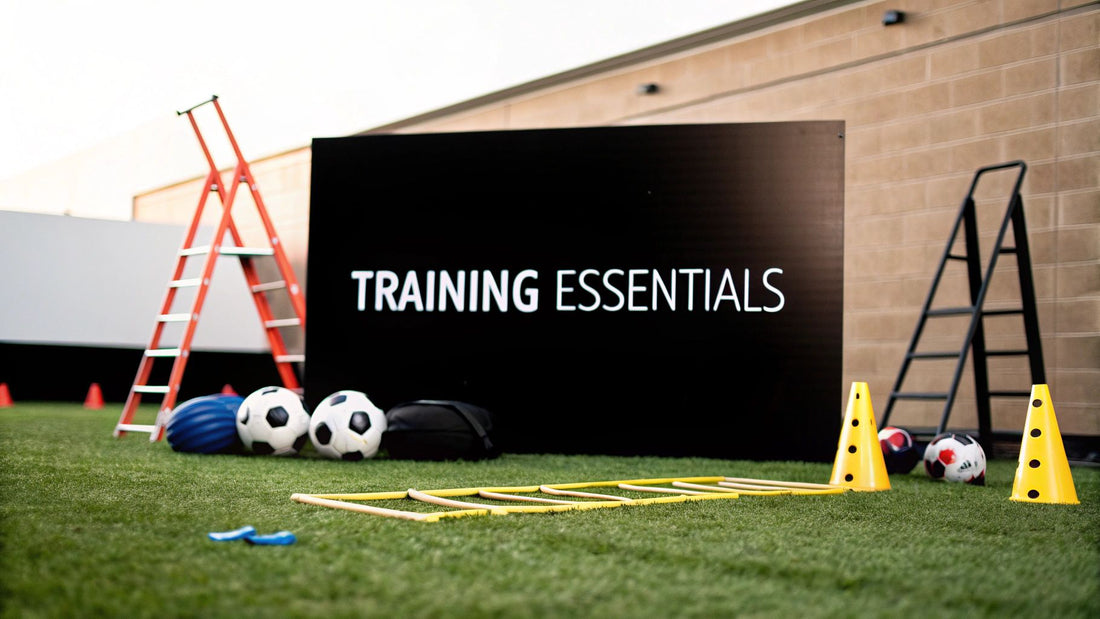Every coach knows that a win on Saturday is earned on the training pitch during the week. Having the right tools makes a world of difference. The football training equipment every coach needs isn't just a random shopping list; it's a carefully chosen set of gear that builds skills, fitness, and safety into every session.
Getting the right equipment is the first step in creating a training environment where your players can genuinely grow and improve.
Building Your Complete Coaching Toolkit
Think of this guide as your roadmap to putting together the perfect coaching arsenal. We'll dig deeper than just listing items and explain why certain pieces of equipment are non-negotiable for real player development. It's like a mechanic's toolbox—you need the basics like spanners and screwdrivers (your balls and cones) before you even think about the fancy diagnostic tools.
We'll cover everything from the gear that helps players master the ball to the modern tech that gives you a proper look at performance data. This is all about making smart investments in your team's future and ensuring every session is purposeful.
The Foundation of Every Session
Let's start with the obvious: the football itself. It's the heart of every drill, every pass, every shot. You can't develop skill without it. The importance of good quality training balls is even reflected in the market's growth. In the UK, the football market, which includes gear like balls, reached around £330 million in 2023 and is expected to climb steadily.
But beyond the ball, a coach needs a few other key items to run a smooth, organised session.
- Cones and Markers: These are your best friends for marking out pitches, setting up dribbling courses, or teaching players about space and positioning.
- Training Bibs: Absolutely essential for splitting into teams for small-sided games or making roles clear during tactical drills.
- A Reliable Whistle and Stopwatch: The classic tools. You need them to manage the session, keep time, and track progress on fitness drills.
Building a great toolkit isn't about buying the most expensive gear. It's about having the right gear to teach the fundamentals, build fitness, and keep your sessions running like clockwork. Every piece should have a clear purpose.
To get a better handle on the basics, you might want to check out our overview of fundamental football training equipment. Nailing this part means every session has structure, which is the perfect foundation for getting into more advanced stuff later on.
Mastering the Fundamentals with Essential Gear
Before you can think about complex tactics and slick passing plays, you have to get the basics right. For that, you need the right gear. The foundational equipment every coach needs isn't flashy, but it’s the bedrock of every decent training session.
Without these essentials, you're just having a kickabout. With them, you start building the muscle memory and instincts that players fall back on when the pressure is on in a real match. It all begins with the most obvious tool of all: the football.
The Right Football for the Job
It sounds simple, but not all footballs are created equal. Using the wrong one can seriously hamper a player's development. A heavy, waterlogged ball will kill a player’s touch and confidence, while a ball that’s too light will teach them all the wrong habits for passing and shooting.
Getting this right is one of the easiest wins a coach can have. There are three main types you'll come across, and knowing the difference is crucial for making your training count.
- Training Balls: Think of these as the workhorses of your equipment bag. They’re built tough, usually from TPU or PVC, to withstand hours of drills on all sorts of surfaces. They prioritise durability over the perfect feel of a match ball, which makes them a smart, cost-effective choice for the daily grind.
- Match Balls: These are for game day only. Made from higher-quality materials like polyurethane, they offer a softer touch, a more predictable flight, and consistent performance. Keeping them just for matches helps your players get used to the exact feel and response they can expect when it really matters.
- Specialised Balls: This group includes things like futsal balls (which are smaller, heavier, and have a low bounce for close control), lightweight balls for the little ones, and even weighted balls for goalkeeper training.
Picking the right size is also non-negotiable. Watching a young kid struggle with a Size 5 ball is painful; they’ll develop all sorts of awkward techniques just to cope. To get the full picture on choosing the perfect ball for your squad, have a look at our detailed guide on football training balls.
Cones and Markers: The Language of the Pitch
Never think of cones and markers as just plastic obstacles. They’re how a coach communicates on the training ground without saying a word. They’re how you define spaces, set up dribbling channels, and teach vital spatial awareness.
Take a look at the image below. It perfectly shows how a few cones can turn an empty patch of grass into an organised, effective training drill.

This is what it's all about—creating a structured learning environment that guides players through specific movements and patterns, building good habits from the ground up.
Core Equipment for Building Foundational Skills
To get started, you don't need a warehouse full of gear. You just need the non-negotiables that help teach ball control, positioning, and team organisation. Here’s a quick rundown of what every coach should have in their boot.
| Equipment Type | Primary Use in Training | Key Selection Criteria |
|---|---|---|
| Footballs | Developing touch, passing, and shooting technique. | Correct size for age group; durable material for training. |
| Cones & Markers | Defining drill areas, creating dribbling paths, marking positions. | Bright, visible colours; variety of shapes (flat vs. tall). |
| Training Bibs | Differentiating teams for drills and small-sided games. | Lightweight, breathable material; contrasting colours. |
With just these three items, you have everything you need to run dynamic, organised, and effective sessions that lay the groundwork for more advanced skills.
Bibs for Clarity and Organisation
Last but not least is the humble training bib. It’s so easy to overlook, but it’s absolutely essential. Ever tried running a small-sided game without them? It’s chaos. Bibs provide instant visual clarity, letting players recognise teammates and opponents in a split second.
Bibs do more than just separate teams; they streamline communication and decision-making. When a player can instantly identify a teammate in their peripheral vision, their speed of play naturally increases. This simple piece of kit is vital for organising drills that mimic the pace and pressure of a real match.
Unlocking Player Speed and Agility
In today's game, pure pace and the ability to turn on a sixpence can separate a good player from a truly great one. You can have all the technical skill in the world, but physical prowess is what often sets the elite athletes apart. This is exactly where dedicated speed and agility gear comes in, helping you mould players into dynamic, explosive assets on the pitch.

This kind of equipment isn’t about just getting players to run fast in a straight line; it's about developing "football-fast" movement. We're talking about explosive acceleration, sharp stops, and slick changes of direction that look exactly like what happens in a real match—an attacker ghosting past a defender or a midfielder closing down space in a flash.
Agility Ladders for Quick Feet and Coordination
The agility ladder is a staple in any serious coach's bag, and for good reason. It’s so much more than a tool for fancy footwork drills. The real job of the ladder is to fine-tune the connection between a player's brain and their feet, sharpening up what's known as neuromuscular efficiency.
Put simply, it teaches players to fire the right muscles in the right order, which leads to quicker, more controlled movements. Using ladders regularly is fantastic for:
- Improving Coordination and Balance: Players get a much better feel for body control while moving at pace.
- Enhancing Foot Speed: All that repetition builds the muscle memory needed for lightning-fast footwork.
- Boosting Quickness Off the Mark: Those first few steps are critical, and ladder work is brilliant for training explosive starts.
Think of it as teaching a player’s feet to think for themselves. When they don’t have to consciously plan every step, their reaction time during a match goes through the roof.
Hurdles and Poles for Explosive Power
While ladders are all about quick feet, hurdles and poles are your go-to for building raw, explosive power and fluid movement. They’re absolutely essential for developing plyometric strength—that ability to generate maximum force in the shortest possible time.
Using low hurdles for bounding or jumping drills forces players to generate power from their legs, which directly improves their vertical leap and sprint acceleration. Agility poles, on the other hand, are perfect for weaving drills that mimic dribbling through a packed defence or making sharp, evasive runs off the ball.
The real magic of this football training equipment is its ability to build functional movement patterns. The goal isn't just to clear a hurdle; it's to train the body to react with explosive power in a way that directly mirrors the demands of a 90-minute match.
This focus on functional agility has become a massive part of modern coaching. The global demand for specialised training gear reflects this trend, with a huge emphasis in the UK on equipment that develops speed and coordination. A typical drill might involve a player weaving through a set of agility poles before exploding over a series of low hurdles. This combination directly copies the actions of an attacker beating a defender and then accelerating into open space, making your training sessions far more relevant and effective.
Building Stronger and More Resilient Players
Technical skill is great, but it means very little if a player is gassed by the 70th minute or constantly stuck on the sidelines with an injury. A player’s ability to last a full 90 minutes and stay injury-free is a massive competitive advantage.
This is where we shift our focus from the ball to the body. It’s not about turning footballers into bodybuilders. It's about forging robust, powerful athletes who can handle the intense physical demands of the game, win their individual battles, and most importantly, stay on the pitch all season long. Let’s look at the football training equipment that builds genuine physical resilience.
Resistance Bands for Activation and Strength
Every coach should have a bag full of resistance bands. They’re one of the most versatile and cost-effective tools you can own. Forget thinking of them as just for physio; they are perfect for getting players switched on before a session.
Simple exercises like banded glute bridges or lateral walks fire up key muscle groups, preparing players’ bodies for explosive movements and drastically reducing injury risk. Beyond the warm-up, they add a new layer of challenge to strength work. Placing a band around the knees during squats forces players to maintain stability and control, building strength through a full range of motion. This is exactly what’s needed to hold off opponents and keep your balance on the ball.
True resilience is built by strengthening the muscles that support and protect the body during high-intensity actions. Resistance bands are a superb tool for this, targeting stabiliser muscles that are often neglected in traditional strength training.
Developing a Powerful Core with Medicine Balls
A strong core is the epicentre of a player's power, balance, and stability. And for developing that crucial area, nothing beats a medicine ball. This simple piece of kit moves you beyond basic crunches and into dynamic, rotational movements that actually mimic what players do on the pitch—shooting, passing, and changing direction.
Think about drills like Russian twists or medicine ball slams. These exercises build explosive core strength, which is vital for generating power in a shot or staying firm in a 50/50 challenge. A player with a solid core is just harder to knock off the ball and more efficient in every single movement they make.
Speed Parachutes for Explosive Sprinting
If you want to build raw sprinting power, you have to train against resistance. Speed parachutes are brilliant for this. They create drag that forces a player's leg muscles to work harder with every single stride.
This overloads the specific muscles involved in acceleration, helping to develop a much more powerful and explosive first step. The beauty of the parachute is its simplicity. After just a few resisted sprints, releasing the parachute gives the player an incredible feeling of lightness and speed, helping to fine-tune their sprint mechanics and boost their top-end pace.
Using Data to Coach Smarter
A coach's gut feeling is still vital on the touchline, but modern football increasingly runs on data. Tech now gives us an incredibly deep and accurate look at player performance, taking much of the guesswork out of big coaching calls. This is where wearable GPS vests and trackers come in. Think of them as your analytical assistant coach, right there on the training ground.

These pieces of kit provide the hard numbers to back up what your eyes are telling you. They track key metrics that paint a crystal-clear picture of a player’s physical output during a session, moving beyond simple observation to give you actionable insights.
What Are the Key Metrics to Watch?
At its core, GPS tracking captures a huge amount of information about how a player moves and the effort they put in. It can seem like a lot to take in at first, but a few core metrics will give you immediate value, no matter what level you’re coaching at.
- Total Distance Covered: This is your bread and butter. It tells you the sheer volume of work a player has put in, which is vital for managing their load over the week.
- Sprint Speed and Distance: This metric instantly flags your fastest players and, more importantly, shows how often they’re hitting top gear. It’s a brilliant indicator of match-day intensity.
- Heart Rate Zones: By keeping an eye on heart rate, you can see exactly how hard a player’s cardiovascular system is working. This helps you tailor fitness drills to the perfect intensity.
- Accelerations and Decelerations: Those sharp bursts of speed and sudden stops are often more taxing than a long, steady run. They’re also a massive indicator of fatigue.
Think of this data as a physical report card for each player after every single session. It lets you see who’s pushing their limits, who might be coasting, and—crucially—who is at risk of overtraining before an injury happens.
Turning Numbers into Better Decisions
Collecting data is only half the job. The real art is in reading it and making smarter coaching decisions. The rapid uptake of wearable tech in UK football shows just how valuable these insights have become, with performance technology being a key driver in the growth of the global football equipment market.
With this information at your fingertips, you can manage player workloads with real precision. You’ll know exactly when a player needs a lighter session to avoid burnout. On the flip side, the data will highlight which players are consistently performing well and are ready for more intensive work without being pushed into the red zone. This whole approach is about one thing: making sure your team turns up on match day in peak physical condition.
Want to go deeper on this? You might be interested in our guide on the benefits of football GPS tracking.
Don't Forget Your Goalkeeper (Or Their Recovery!)
It's easy to get laser-focused on your outfield players, but a winning team is built on more than just slick passing and sharp strikers. Two areas that truly separate good teams from great ones are specialised goalkeeper training and a solid player recovery plan.
Smart coaching means looking after every player, from the moment they step onto the training pitch to long after the final whistle. Investing in the right gear for your keepers and for squad recovery isn't a luxury; it's a must. It’s what ensures your number one is just as sharp as your number nine, and that your whole team stays fit and ready for match day.
Honing Your Goalkeeper’s Reflexes
Goalkeepers are a different breed, and their training needs to be just as unique. Lobbing a few shots at them at the end of a session just won't cut it. They need drills that sharpen reaction times, improve handling under pressure, and perfect their footwork. This is where specialist tools really come into their own.
- Rebounders: These are brilliant for mimicking those unpredictable deflections and quick-fire shots a keeper faces in a real match. A good quality rebounder, like the ones from SoccerWares, lets a keeper train solo, honing their reflexes and shot-stopping technique with all sorts of returns.
- Reflex Balls: These unevenly shaped balls are fantastic. They bounce in completely random directions, forcing goalkeepers to stay light on their feet and make split-second adjustments. They’re perfect for warm-ups or close-range handling drills.
The goalkeeper position is arguably the most psychologically demanding on the pitch. Giving them dedicated, effective training equipment doesn't just build their skills—it shows them they're a valued and vital part of the team's success.
Making Recovery an Active Part of Training
Player recovery isn’t something you can afford to skip. It's essential for preventing injuries and keeping the squad fresh through a long, gruelling season. The best approach is to stop seeing recovery as an afterthought and start making it an active, planned part of every session.
You don't need a huge budget, either. Simple, low-cost items can make a massive difference. Foam rollers are fantastic for self-myofascial release, helping to ease muscle tightness and improve flexibility. For those smaller, hard-to-reach knots, massage balls are perfect.
Just adding a dedicated 10-minute cool-down with these tools can slash muscle soreness and get players' bodies ready for the next session. It's this kind of proactive player care that marks out a smart, forward-thinking coach.
Common Questions from Coaches
When you're starting to build out your kit bag, the same questions always seem to crop up. Let's cut through the noise and get you some straight answers so you can make smart choices for your team and your budget.
I'm on a Tight Budget. What Do I Absolutely Need?
If you're just starting out or club funds are looking a bit thin, don't panic. You can run fantastic, high-energy sessions with just the bare essentials. Forget the fancy gadgets for now.
Focus on these three non-negotiables:
- Quality Footballs: Get the right number and, crucially, the right size for your squad. This is the one area you shouldn't skimp on.
- A Good Set of Cones: A stack of brightly coloured disc cones is your best friend. You can use them to mark out pitches, create passing grids, or set up dribbling courses—the possibilities are endless.
- Bibs in Two Colours: Simple, but essential. You can't run a small-sided game or organise drills without them.
How Do I Know Which Size Football to Buy?
This is a big one. Using the wrong size ball really holds players back, affecting their touch, control, and even their confidence. Thankfully, the official breakdown is simple and based on age.
Here’s the FA guidance:
- Size 3: For the little ones, aged 6-9.
- Size 4: For players hitting their stride, aged 10-14.
- Size 5: The standard size for everyone aged 14 and up.
For most grassroots clubs, mastering the fundamentals with basic equipment provides a far better return on investment than expensive technology. Focus on quality coaching and foundational gear before considering high-end analytics.
Don't be tempted by expensive GPS vests you see the pros wearing. That money is far better spent on more footballs or a set of portable goals. Nail the basics first.

